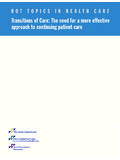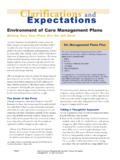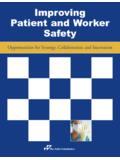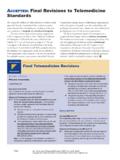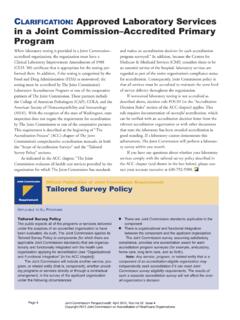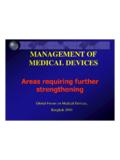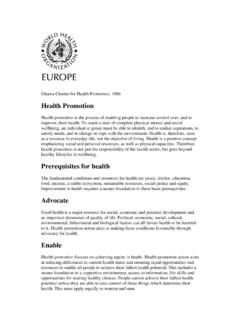Transcription of Prepublication Requirements - Accreditation, Health Care ...
1 Prepublication RequirementsThe joint commission has approved the following revisions for Prepublication . While revised Requirements are published in the semiannual updates to the print manuals (as well as in the online E-dition ), certified organizations and paid subscribers can also view them in the monthly periodical The joint commission Perspectives . To begin your subscription, call 800-746-6578 or visit Issued October 30, 2017; Effective November 15, 2017 Standards Revisions for Emergency Management Final Rule in HospitalStandard (s) of Performance for hospital engages in planning activities prior to developing its written Emergency Operations Plan. Note: An emergency is an unexpected or sudden event that significantly disrupts the organization s ability to provide care , or the environment of care itself, or that results in a sudden, significantly changed or increased demand for the organization's services.
2 Emergencies can be either human-made or natural (such as an electrical system failure or a tornado), or a combination of both, and they exist on a continuum of severity. A disaster is a type of emergency that, due to its complexity, scope, or duration, threatens the organization s capabilities and requires outside assistance to sustain patient care , safety, or security hospital conducts a hazard vulnerability analysis (HVA) to identify potential emergencies that could affect demand for the hospital s services or its ability to provide those services, the likelihood of those events occurring, and the consequences of those events. The findings of this analysis are documented. (See also , EP 1; , EP 4) Note 1: Hospitals have flexibility in creating either a single HVA that accurately reflects all sites of the hospital, or multiple HVAs.
3 Some remote sites may be significantly different from the main site (for example, in terms of hazards, location, and population served); in such situations a separate HVA is 2: If the hospital identifies a surge in infectious patients as a potential emergency, this issue is addressed in the "Infection Prevention and Control" (IC) hospital conducts a hazard vulnerability analysis (HVA) to identify potential emergencies within the organization and the community that could affect demand for the hospital s services or its ability to provide those services, the likelihood of those events occurring, and the consequences of those events. The findings of this analysis are documented. (See also , EP 1; , EP 4) Note 1: Hospitals have flexibility in creating either a single HVA that accurately reflects all sites of the hospital, or multiple HVAs.
4 Some remote sites may be significantly different from the main site (for example, in terms of hazards, location, and population served); in such situations a separate HVA is 2: If the hospital identifies a surge in infectious patients as a potential emergency, this issue is addressed in the "Infection Prevention and Control" (IC) 2017 The joint CommissionPage 1 of 6 Prepublication Requirements continued Issued October 30, 2017; Effective November 15, 2017 Standard (s) of Performance for hospital has an Emergency Operations Plan. Note: The hospital s Emergency Operations Plan (EOP) is designed to coordinate its communications, resources and assets, safety and security, staff responsibilities, utilities, and patient clinical and support activities during an emergency (refer to Standards , , , , , and ).
5 Although emergencies have many causes, the effects on these areas of the organization and the required response effort may be similar. This "all hazards" approach supports a general response capability that is sufficiently nimble to address a range of emergencies of different duration, scale, and cause. For this reason, the plan s response procedures address the prioritized emergencies but are also adaptable to other emergencies that the organization may hospitals that use joint commission accreditation for deemed status purposes: The Emergency Operations Plan includes a continuity of operations strategy that covers the following:- A succession plan that lists who replaces key leaders during an emergency if a leader is not available to carry out his or her duties- A delegation of authority plan that describes the decisions and policies that can be implemented by authorized successors during an emergency and criteria or triggers that initiate this delegationNote: A continuity of operations strategy is an essential component of emergency management planning.
6 The goal of emergency management planning is to provide care to individuals who are incapacitated by emergencies in the community or in the organization. A continuity of operations strategy focuses on the organization, with the goal of protecting the organization s physical plant, information technology systems, business and financial operations, and other infrastructure from direct disruption or damage so that it can continue to function throughout or shortly after an emergency. When the organization itself becomes, or is at risk of becoming, a victim of an emergency (power failure, fire, flood, bomb threat, and so forth), it is the continuity of operations strategy that provides the resilience to respond and hospitals that use joint commission accreditation for deemed status purposes: If a hospital has one or more transplant centers (see Glossary), the following must occur.
7 - A representative from each transplant center must be included in the development and maintenance of the hospital's emergency preparedness program- The hospital must develop and maintain mutually agreed upon protocols that address the duties and responsibilities of the hospital, each transplant center, and the organ procurement organization (OPO) for the donation service area where the hospital is situated, unless the hospital has been granted a waiver to work with another OPO, during an hospitals that use joint commission accreditation for deemed status purposes: The hospital has a procedure for requesting an 1135 waiver for care and treatment at an alternative care site. Note: During disasters, organizations may need to request 1135 waivers to address care and treatment at an alternate care site identified by emergency management officials.
8 The 1135 waivers are granted by the federal government during declared public Health emergencies; these waivers authorize modification of certain federal regulatory Requirements (for example, Medicare, Medicaid, Children s Health Insurance Program, Health Insurance Portability and Accountability Act) for a defined time period during response and Emergency Operations Plan describes a means to shelter patients, staff, and volunteers on site who remain in the 2017 The joint CommissionPage 2 of 6 Prepublication Requirements continued Issued October 30, 2017; Effective November 15, 2017 For hospitals that use joint commission accreditation for deemed status purposes: The hospital has one or more emergency management policies based on the emergency plan, risk assessment, and communication plan. Procedures guiding implementation are defined in the emergency management plan, continuity of operations plan, and other preparedness and response protocols.
9 Policy and procedure documents are reviewed and updated on an annual basis; the format of these documents is at the discretion of the (s) of Performance for part of its Emergency Operations Plan, the hospital prepares for how it will communicate during hospitals that use joint commission accreditation for deemed status purposes: As part of its communication plan, the hospital maintains the names and contact information of the following:- Staff- Physicians- Other hospitals and CAHs- Volunteers- Entities providing services under arrangement- Relevant federal, state, tribal, regional, and local emergency preparedness staff- Other sources of hospitals that use joint commission accreditation for deemed status purposes: The Emergency Operations Plan describes the following:- Process for communicating information about the general condition and location of patients under the organization s care to public and private entities assisting with disaster relief- Process, in the event of an evacuation, to release patient information to family, patient representative, or others responsible for the care of the patientNote: These processes are consistent with privacy and disclosure Requirements specified under 45 CFR (b)(1)(ii) and 45 CFR (b)(4).
10 Hospitals that use joint commission accreditation for deemed status purposes: The organization maintains documentation of completed and attempted contact with the local, state, tribal, regional, and federal emergency preparedness officials in its service area. This contact is made for the purpose of communication, and where possible collaboration, on coordinated response planning for a disaster or emergency : Examples of these contacts may be written or email correspondence; in-person meetings or conference calls; regular participation in Health care coalitions, working groups, boards, and committees; or educational events sponsored by a third party (such as a local or state Health department). 2017 The joint CommissionPage 3 of 6 Prepublication Requirements continued Issued October 30, 2017; Effective November 15, 2017 Standard (s) of Performance for part of its Emergency Operations Plan, the hospital prepares for how it will manage resources and assets during Emergency Operations Plan describes the following: How the hospital will obtain and replenish nonmedical supplies that will be required throughout the response and recovery phases of an Emergency Operations Plan describes the following.
